
The Enchanting Øgadekvarteret: Aarhus' Hidden Gem
Discover Øgadekvarteret in Aarhus: An enchanting neighbourhood blending historical charm, vibrant arts, and delightful eateries, perfect for a leisurely exploration.
Nestled in the heart of Aarhus, Øgadekvarteret is an enchanting neighbourhood that offers a unique blend of historical charm and modern vibrancy. This area is well-known for its picturesque streets lined with beautifully preserved townhouses, each telling a story of the city's rich architectural heritage. As you stroll through the cobbled pathways, you will be captivated by the colourful facades and intricate details that make Øgadekvarteret a visual delight. The neighbourhood is not just about aesthetics; it is a cultural hub with a thriving arts scene. Small galleries, boutique shops, and cosy cafes populate the area, providing a perfect setting for leisurely exploration. Local artisans and creatives often showcase their work here, making it a great spot to pick up unique souvenirs and gifts. The atmosphere is warm and welcoming, inviting you to slow down and soak in the local vibe. Øgadekvarteret is also home to some of Aarhus' best eateries. From traditional Danish fare to international cuisine, the dining options are plentiful and varied. Whether you're in the mood for a hearty meal or a light snack, you will find something to satisfy your palate. The neighbourhood's proximity to the city centre makes it an ideal starting point for further exploration of Aarhus. With its blend of history, culture, and gastronomy, Øgadekvarteret is a must-visit for any traveller.
Local tips in Øgadekvarteret
- Visit on weekdays to avoid the weekend crowds and get a more authentic local experience.
- Wear comfortable shoes as the cobblestone streets can be uneven.
- Check out the local galleries and shops for unique, handcrafted items.
- Try traditional Danish pastries at one of the neighbourhood's cosy cafes.
- Use public transport or rent a bike to explore the area and its surroundings efficiently.
The Enchanting Øgadekvarteret: Aarhus' Hidden Gem
Nestled in the heart of Aarhus, Øgadekvarteret is an enchanting neighbourhood that offers a unique blend of historical charm and modern vibrancy. This area is well-known for its picturesque streets lined with beautifully preserved townhouses, each telling a story of the city's rich architectural heritage. As you stroll through the cobbled pathways, you will be captivated by the colourful facades and intricate details that make Øgadekvarteret a visual delight. The neighbourhood is not just about aesthetics; it is a cultural hub with a thriving arts scene. Small galleries, boutique shops, and cosy cafes populate the area, providing a perfect setting for leisurely exploration. Local artisans and creatives often showcase their work here, making it a great spot to pick up unique souvenirs and gifts. The atmosphere is warm and welcoming, inviting you to slow down and soak in the local vibe. Øgadekvarteret is also home to some of Aarhus' best eateries. From traditional Danish fare to international cuisine, the dining options are plentiful and varied. Whether you're in the mood for a hearty meal or a light snack, you will find something to satisfy your palate. The neighbourhood's proximity to the city centre makes it an ideal starting point for further exploration of Aarhus. With its blend of history, culture, and gastronomy, Øgadekvarteret is a must-visit for any traveller.
Iconic landmarks you can’t miss
The Old Town
Den Gamle By in Aarhus offers a journey through centuries of Danish urban history, blending immersive architecture, costumed interpreters, and engaging period exhibits.
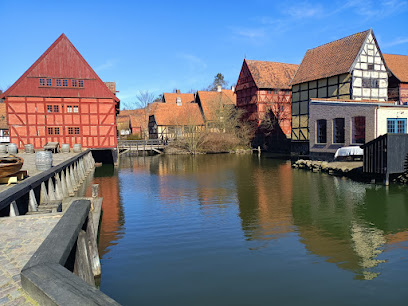
ARoS Aarhus Art Museum
Iconic contemporary art museum in Aarhus known for bold exhibitions, interactive experiences, and the mesmerizing rooftop rainbow panorama overlooking the city.
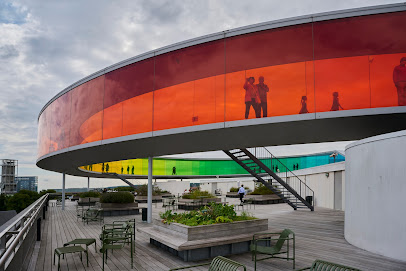
Greenhouses in the Botanical Garden
Aarhus Botanical Garden’s Greenhouses: explore captivating tropical jungles, arid deserts, and rare plant collections in a stunning modern glass oasis.
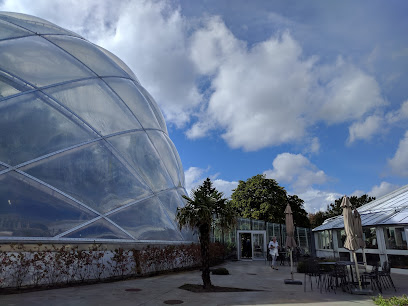
Aarhus Cathedral
Experience the grandeur of Aarhus Cathedral, Denmark’s tallest church, featuring stunning Gothic architecture, medieval frescoes, and panoramic city views.
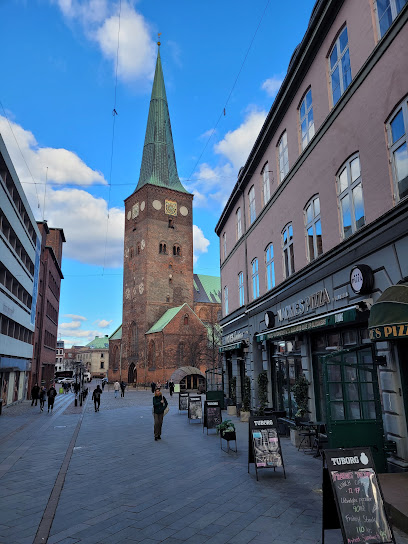
Klostertorvet
Klostertorvet is Aarhus’s vibrant plaza, fusing historic monastery grounds with a lively social scene, independent cafés, and open-air city life in the heart of Denmark.
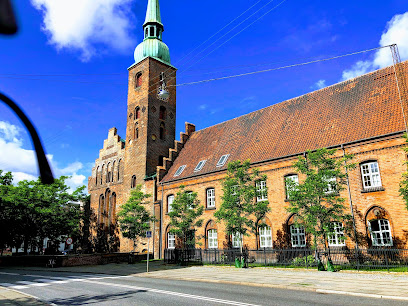
Steno Museum
Explore the Steno Museum in Aarhus, where science and history come alive through engaging exhibits and interactive experiences.
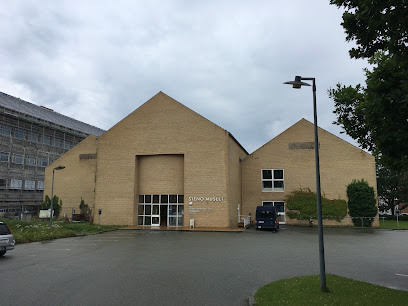
Udsigtspladsen
Discover Udsigtspladsen, the serene viewpoint in Aarhus C, where locals and visitors gather for panoramic city and bay vistas above lively Øgadekvarteret.
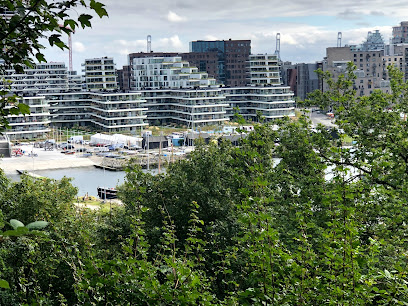
Store Torv
Store Torv is the historic plaza at Aarhus’ city heart, a hub of medieval charm, vibrant markets, and the dramatic silhouette of Denmark’s tallest cathedral.
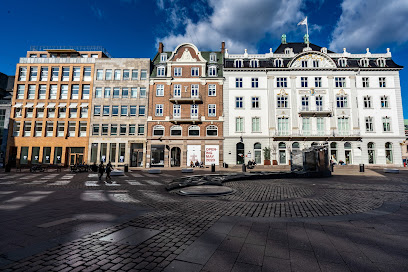
Aarhus waterfront
Aarhus Waterfront blends urban vibrancy, Nordic design, and harbor heritage with panoramic sea views and lively promenades, making it a quintessential Danish experience.
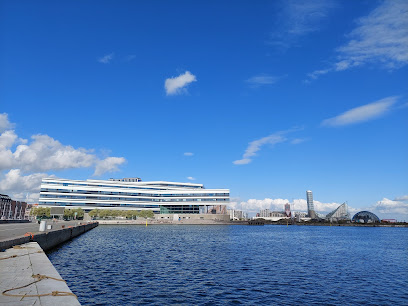
Latin Quarter
Winding medieval streets, indie boutiques, and lively cafés make Aarhus’ Latin Quarter a bohemian haven blending Danish history and cutting-edge culture.
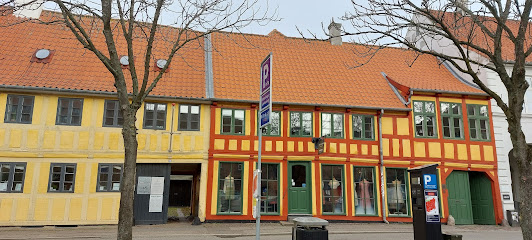
Mindrebæltsbroen
Vibrant urban bridge transformed into Aarhus’ open-air street art gallery, revealing the creative soul of Øgadekvarteret’s lively neighborhood.
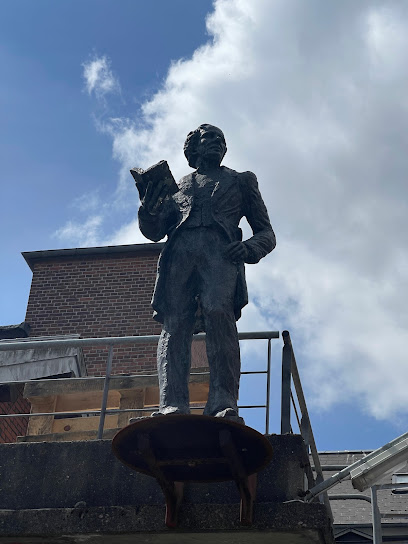
Essential places to dine
Den Rustikke
Experience authentic Danish cuisine at Den Rustikke in Aarhus - where local ingredients meet rustic charm.
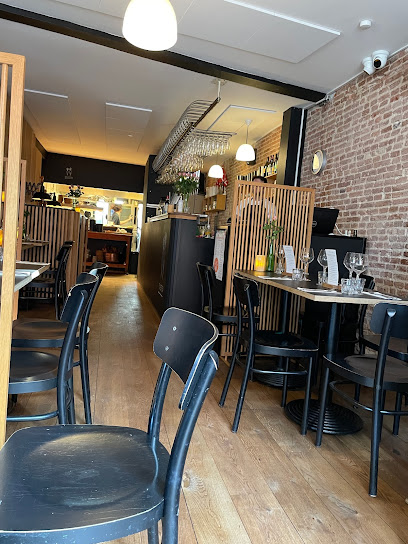
Slap Af
Experience the vibrant culinary scene at Slap Af in Aarhus – where exquisite dishes meet expertly crafted cocktails.
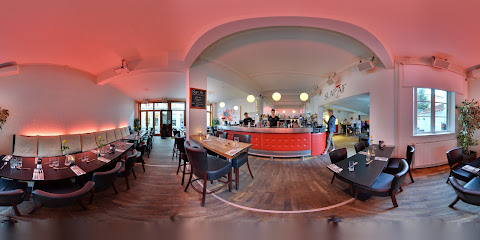
Langhoff & Juul
Aarhus’s Langhoff & Juul serves modern Nordic cuisine and natural wines in a cozy, design-forward setting focused on organic, local ingredients and sustainability.
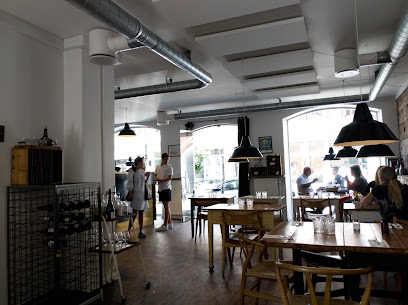
Møf
Modern Danish restaurant in central Aarhus C, celebrated for innovative seasonal menus, welcoming hygge vibes, and memorable Nordic culinary artistry.
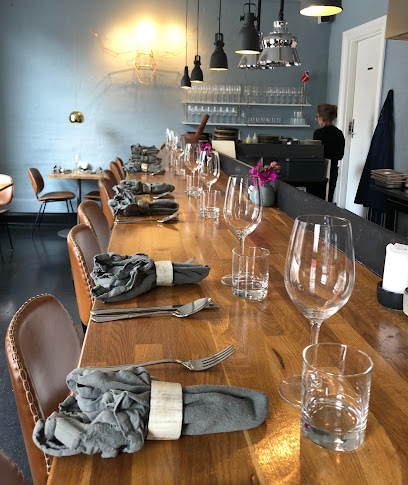
Restaurant Domestic
Restaurant Domestic delivers an award-winning New Nordic dining adventure in central Aarhus, blending local ingredients, inventive technique, and elegant Danish atmosphere.
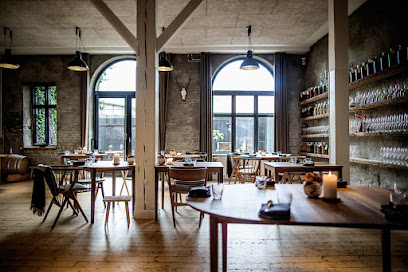
Pihlkjær Restaurant
Historic ambiance and inventive Nordic cuisine combine at Pihlkjær Restaurant, a cherished spot in central Aarhus for modern Danish dining and local flavors.
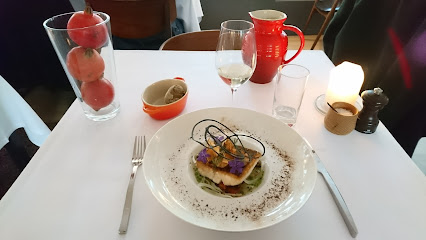
Gastro & Vino
Discover exquisite Danish cuisine and thoughtfully paired wines in an intimate, backyard setting at Gastro & Vino, one of Aarhus’s most celebrated culinary gems.
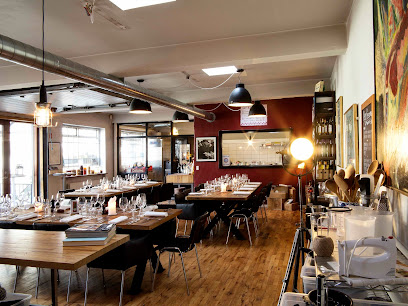
Local Phrases
-
- HelloHej
[hey] - GoodbyeFarvel
[far-vel] - YesJa
[ya] - NoNej
[nay] - Please/You're welcomeVær så god
[ver so go] - Thank youTak
[tak] - Excuse me/SorryUndskyld
[un-skeel] - How are you?Hvordan har du det?
[vor-dan har doo deh] - Fine. And you?Fint. Og dig?
[feent. oh day] - Do you speak English?Taler du engelsk?
[ta-ler doo eng-elsk] - I don't understandJeg forstår ikke
[yay for-stor ee-keh]
- HelloHej
-
- I'd like to see the menu, pleaseJeg vil gerne se menuen, tak
[yay veal gehr-neh seh mern-oo-en, tak] - I don't eat meatJeg spiser ikke kød
[yay spees-er ee-keh kuhd] - Cheers!Skål!
[skawl] - I would like to pay, pleaseJeg vil gerne betale, tak
[yay veal gehr-neh beh-tah-leh, tak]
- I'd like to see the menu, pleaseJeg vil gerne se menuen, tak
-
- Help!Hjælp!
[hyelp] - Go away!Gå væk!
[goh vek] - Call the Police!Ring til politiet!
[ring teel poh-lee-tee-eh] - Call a doctor!Ring efter en læge!
[ring af-ter en lay-eh] - I'm lostJeg er faret vild
[yay ehr fah-reht veel] - I'm illJeg er syg
[yay ehr sook]
- Help!Hjælp!
-
- I'd like to buy...Jeg vil gerne købe...
[yay veal gehr-neh kuh-beh] - I'm just lookingJeg kigger bare
[yay kee-ger bah-reh] - How much is it?Hvor meget koster det?
[vor meh-yeh koh-stehr deh] - That's too expensiveDet er for dyrt
[deh ehr for deert] - Can you lower the price?Kan du sænke prisen?
[kan doo saen-keh pree-sen]
- I'd like to buy...Jeg vil gerne købe...
-
- What time is it?Hvad er klokken?
[vah eh kloh-ken] - It's one o'clockDen er et
[dehn ehr et] - Half past (10)Halv ti
[halv tee] - MorningMorgen
[mohr-gehn] - AfternoonEftermiddag
[ef-ter-mee-dah] - EveningAften
[ahf-tehn] - YesterdayI går
[ee gaw] - TodayI dag
[ee dah] - TomorrowI morgen
[ee mohr-gehn] - 1Et
[et] - 2To
[toh] - 3Tre
[treh] - 4Fire
[feer-eh] - 5Fem
[fem] - 6Seks
[seks] - 7Syv
[suv] - 8Otto
[oh-toh] - 9Ni
[nee] - 10Ti
[tee]
- What time is it?Hvad er klokken?
-
- Where's a/the...?Hvor er en/et...?
[vor ehr en/et] - What's the address?Hvad er adressen?
[vah eh ah-dras-sehn] - Can you show me (on the map)?Kan du vise mig (på kortet)?
[kan doo vee-seh mee (poh kort-eh)] - When's the next (bus)?Hvornår er næste (bus)?
[vor-nor ehr ne-steh (boos)] - A ticket (to ....)Et billet (til ....)
[et bee-leht (teel)]
- Where's a/the...?Hvor er en/et...?
History of Øgadekvarteret
-
Øgadekvarteret, known for its vibrant community and cultural significance, began to take shape in the late 19th century. The area was originally a part of the urban expansion that accompanied Aarhus's industrial growth. The establishment of various factories and warehouses attracted workers to the region, which led to a rapid increase in population and the need for residential housing.
-
The architectural landscape of Øgadekvarteret is characterized by a blend of historic and modern styles. Many buildings date back to the early 20th century, showcasing beautiful brickwork and Art Nouveau designs. This neighborhood served as a melting pot of different architectural influences, reflecting the socio-economic changes that Aarhus underwent during the industrial era.
-
In the 20th century, Øgadekvarteret became a hub for cultural activities. The establishment of local theaters, galleries, and community centers contributed to a rich cultural life. The area embraced diverse artistic expressions, and many artists and musicians found inspiration in its dynamic atmosphere, further enriching Aarhus's cultural tapestry.
-
In recent years, Øgadekvarteret has undergone significant transformation and gentrification. The neighborhood has attracted new businesses, cafes, and boutiques, appealing to both residents and tourists. This revitalization has preserved the area's historical charm while integrating modern amenities, making it a sought-after destination in Aarhus.
-
Today, Øgadekvarteret is celebrated for its strong sense of community. Local initiatives and events foster social interactions among residents, creating a vibrant neighborhood identity. The area's history is honored through various cultural festivals and activities, ensuring that the legacy of Øgadekvarteret remains alive and relevant in the contemporary context of Aarhus.
Øgadekvarteret Essentials
-
Øgadekvarteret is easily accessible from other neighbourhoods in Aarhus. You can take the light rail (Aarhus Letbane) to the 'Aarhus Universitet' stop, which is just a short walk from Øgadekvarteret. Additionally, several bus lines, including routes 1 and 5, provide direct connections to Øgadekvarteret from the city center and surrounding areas. For those traveling from Aarhus Central Station, a taxi ride will take approximately 10 minutes.
-
Øgadekvarteret is a compact neighbourhood, making it easy to explore on foot or by bicycle. The city of Aarhus promotes cycling, and you can rent bikes from various rental shops or use the city’s bike-sharing system, Bycyklen. Public transport options, including buses and the light rail, are also available, providing easy access to nearby attractions and the city center.
-
Øgadekvarteret is generally a safe neighbourhood for tourists. However, as in any city, it is advisable to remain vigilant. Areas with higher crime rates are typically concentrated in more urban settings, but Øgadekvarteret is not known for such issues. Avoid poorly lit streets at night and keep your belongings secure in crowded places.
-
In case of an emergency, dial 112 for police, fire, or medical assistance in Denmark. The nearest hospital to Øgadekvarteret is Aarhus University Hospital, which can be reached via taxi or public transport. It is advisable to have travel insurance that covers medical emergencies. Pharmacies are available throughout Aarhus, including in Øgadekvarteret, for over-the-counter medications.
-
Fashion: Do wear comfortable clothing suitable for walking. Don't wear offensive or overly revealing attire. Religion: Do respect local customs and traditions, especially when visiting any religious sites. Public Transport: Do pay for your ticket before boarding and be courteous to fellow passengers. Don’t eat or drink on public transport. Greetings: Do greet locals with a friendly smile or a nod; a handshake is common. Eating & Drinking: Do try local cafés and restaurants; don't waste food or be rude to staff.
-
To experience Øgadekvarteret like a local, visit the charming cafés along the canals and participate in community events held in the area. Engage with local artisans in the small shops and take time to explore the cultural offerings, like the local art galleries. For a unique experience, consider joining a guided walking tour that showcases the neighbourhood’s history and architecture. Additionally, try to visit during one of the local festivals for an immersive cultural experience.
Nearby Cities to Øgadekvarteret
-
Things To Do in Randers
-
Things To Do in Silkeborg
-
Things To Do in Horsens
-
Things To Do in Viborg
-
Things To Do in Vejle
-
Things To Do in Kalundborg
-
Things To Do in Herning
-
Things To Do in Odense
-
Things To Do in Kolding
-
Things To Do in Aalborg
-
Things To Do in Nyborg
-
Things To Do in Slagelse
-
Things To Do in Ribe
-
Things To Do in Roskilde
-
Things To Do in Hillerød








